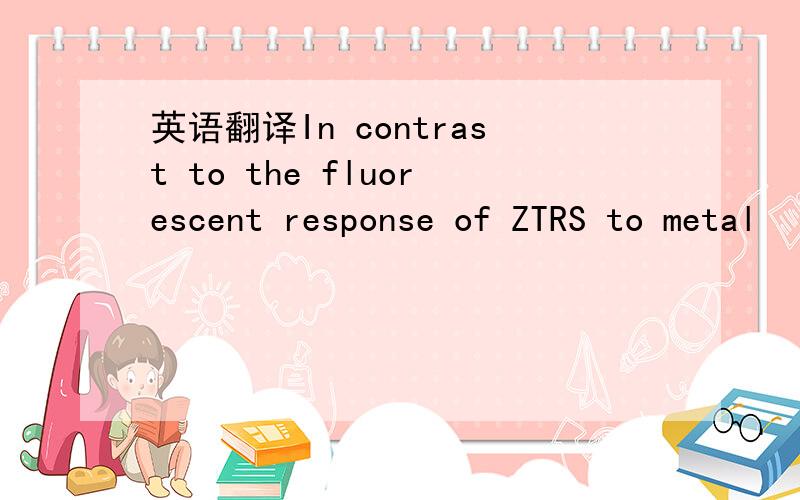英语翻译In contrast to the fluorescent response of ZTRS to metal
来源:学生作业帮 编辑:神马作文网作业帮 分类:英语作业 时间:2024/11/10 23:52:44
英语翻译
In contrast to the fluorescent response of ZTRS to metal ions
in aqueous solutions,in 100% CH3CN Zn2+ and Cd2+ result in
blue-shifted emissions with the maximum wavelength change
from 481 to 430 and 432 nm,respectively (Supporting Information,
Figures S4,S5); however,the addition of Zn2+ and Cd2+
to ZTRS in 100% DMSO cause red-shifted emissions with the
maximum wavelength change from 472 to 512 and 532 nm,
respectively (Supporting Information,Figures S6,S7).The
Figure 1.Influence of pH on the fluorescence of ZTRS in acetonitrile/water (50:50,v/v).Excitation wavelength:360 nm.[ZTRS] ) 10 μM.(a) pH
4.7-12.8.Inset:The fluorescence intensity at 483 nm as a function of pH; (b) pH 4.7-1.8.Inset:The ratiometric fluorescence changes as a function of pH.
Figure 2.(a) Fluorescence spectra of 10 μM ZTRS in the presence of various metal ions in aqueous solution (CH3CN/0.5 M HEPES (pH 7.4) ) 50:50).
Excitation at 360 nm.(b) Fluorescence spectra of ZTRS in the presence of different concentrations of Zn2+.The inset shows the Job plot evaluated from
the fluorescence with a total concentration of 10 μM.addition of other HTM ions results in blue-shift in emissions
in both CH3CN and DMSO (Supporting Information,Figures
S8,S9).However,a small blue-shift of the absorption maximum
of ZTRS in CH3CN,DMSO,and aqueous solution upon
addition of Zn2+ and Cd2+ (Supporting Information,Figures
S10-S15) indicates that the red-shifted emission does not result
from the deprotonation of amide NH group,because the
deprotonation of the NH group conjugated to 1,8-naphthalimide
would cause a red-shift in absorption spectra.18h,25a These
spectral data suggest that ZTRS binds Zn2+ and Cd2+ in
different tautomeric forms,depending on the solvent and metal
ions (Scheme 3); ZTRS complexes both Zn2+ and Cd2+ in the
amide tautomer in CH3CN,and the imidic acid tautomer in
DMSO predominantly.However,other HTM ions bind to the
amide tautomer in both CH3CN and DMSO.
Further evidence for the amide and imidic acid tautomeric
binding modes (Scheme 3) is provided by 1H NMR titration
experiments of ZTRS with Zn2+ and Cd2+ in CD3CN (Supporting
Information,Figures S16,S17) and DMSO-d6 (Supporting
Information,Figures S18,S19),2D NOESY of ZTRS
/Zn2+ (1:1 complex) in CD3CN (Figures 3,Supporting Information,
Figures S20,S21) and DMSO-d6 (Figures 3,S22-23),
and IR spectra of ZTRS/Zn2+ (1:1 complex) in CH3CN
(Supporting Information,Figure S24) and DMSO (Supporting
Information,Figure S25).As a reference,the binding properties
of ZTF with Zn2+ were also examined by means of 1H NMR
and IR spectra.
In contrast to the fluorescent response of ZTRS to metal ions
in aqueous solutions,in 100% CH3CN Zn2+ and Cd2+ result in
blue-shifted emissions with the maximum wavelength change
from 481 to 430 and 432 nm,respectively (Supporting Information,
Figures S4,S5); however,the addition of Zn2+ and Cd2+
to ZTRS in 100% DMSO cause red-shifted emissions with the
maximum wavelength change from 472 to 512 and 532 nm,
respectively (Supporting Information,Figures S6,S7).The
Figure 1.Influence of pH on the fluorescence of ZTRS in acetonitrile/water (50:50,v/v).Excitation wavelength:360 nm.[ZTRS] ) 10 μM.(a) pH
4.7-12.8.Inset:The fluorescence intensity at 483 nm as a function of pH; (b) pH 4.7-1.8.Inset:The ratiometric fluorescence changes as a function of pH.
Figure 2.(a) Fluorescence spectra of 10 μM ZTRS in the presence of various metal ions in aqueous solution (CH3CN/0.5 M HEPES (pH 7.4) ) 50:50).
Excitation at 360 nm.(b) Fluorescence spectra of ZTRS in the presence of different concentrations of Zn2+.The inset shows the Job plot evaluated from
the fluorescence with a total concentration of 10 μM.addition of other HTM ions results in blue-shift in emissions
in both CH3CN and DMSO (Supporting Information,Figures
S8,S9).However,a small blue-shift of the absorption maximum
of ZTRS in CH3CN,DMSO,and aqueous solution upon
addition of Zn2+ and Cd2+ (Supporting Information,Figures
S10-S15) indicates that the red-shifted emission does not result
from the deprotonation of amide NH group,because the
deprotonation of the NH group conjugated to 1,8-naphthalimide
would cause a red-shift in absorption spectra.18h,25a These
spectral data suggest that ZTRS binds Zn2+ and Cd2+ in
different tautomeric forms,depending on the solvent and metal
ions (Scheme 3); ZTRS complexes both Zn2+ and Cd2+ in the
amide tautomer in CH3CN,and the imidic acid tautomer in
DMSO predominantly.However,other HTM ions bind to the
amide tautomer in both CH3CN and DMSO.
Further evidence for the amide and imidic acid tautomeric
binding modes (Scheme 3) is provided by 1H NMR titration
experiments of ZTRS with Zn2+ and Cd2+ in CD3CN (Supporting
Information,Figures S16,S17) and DMSO-d6 (Supporting
Information,Figures S18,S19),2D NOESY of ZTRS
/Zn2+ (1:1 complex) in CD3CN (Figures 3,Supporting Information,
Figures S20,S21) and DMSO-d6 (Figures 3,S22-23),
and IR spectra of ZTRS/Zn2+ (1:1 complex) in CH3CN
(Supporting Information,Figure S24) and DMSO (Supporting
Information,Figure S25).As a reference,the binding properties
of ZTF with Zn2+ were also examined by means of 1H NMR
and IR spectra.

与ZTRS与含水溶液中金属离子的荧光响应相反,在100%CH3CN中,Cd2+和Zn2+产生最大波长从481分别变化到430和432nm的蓝移发射(支持信息的图S4和S5);然而,向100%DMSO中的ZTRS添加Cd2+和Zn2+会引起最大波长从472分别变化到512和532nm的红移发射(支持信息的图S6和S7).添加其他HTM离子会引起在CH3CN和DMSO中发射的蓝移(支持信息的图S8、S9).不过,在添加Cd2+和Zn2+时,在CH3CN、DMSO以及含水溶液中的ZTRS的吸收谱小的蓝移(支持信息的图S10-S15)表明,红移发射不是因为酰胺NH基团去质子化的结果,因为与1,8萘二甲酰亚胺共轭的NH基团的去质子化会引起吸收谱的红移18h,25a.这些光谱数据告诉我们,ZTRS根据溶剂和金属离子(方案3)以不同的互变异构形式与Cd2+和Zn2+结合;ZTRS主要与CH3CN中酰胺互变异构体中的Cd2+和Zn2+络合,以及与DMSO中亚氨酸互变异构体中的Cd2+和Zn2+络合.可是,其他离子与CH3CN和DMSO中的酰胺互变异构体结合.
关于酰胺和亚胺酸互变异构结合模式(方案3)的进一步证据由ZTRS的氢核磁共振(1H NMR)滴定实验,用CD3CN(支持信息的图S16、S17)和DMSO-d6(支持信息的图S18、S19)中的Cd2+和Zn2+,CD3CN(图3,支持信息的图S20/S21)和DMSO-d6(图3,S22、S23)中的ZTRS/Zn2+(1:1络合物)的2维相关核磁共振谱(2D NOESY),以及CH3CN(支持信息的图S24)和DMSO(支持信息的图25)中ZTRS/Zn2+(1:1络合物)的红外光谱提供.作为参考,ZTF与Zn2+的结合性质也用1H NMR和红外光谱进行了研究.
关于酰胺和亚胺酸互变异构结合模式(方案3)的进一步证据由ZTRS的氢核磁共振(1H NMR)滴定实验,用CD3CN(支持信息的图S16、S17)和DMSO-d6(支持信息的图S18、S19)中的Cd2+和Zn2+,CD3CN(图3,支持信息的图S20/S21)和DMSO-d6(图3,S22、S23)中的ZTRS/Zn2+(1:1络合物)的2维相关核磁共振谱(2D NOESY),以及CH3CN(支持信息的图S24)和DMSO(支持信息的图25)中ZTRS/Zn2+(1:1络合物)的红外光谱提供.作为参考,ZTF与Zn2+的结合性质也用1H NMR和红外光谱进行了研究.
英语翻译In contrast to the fluorescent response of ZTRS to metal
英语翻译In contrast to the abundance of data gained frominverteb
英语翻译In addition,in contrast to the AICPA Code of Ethics,Germ
英语翻译如:In contrast to the design of reinforced concrete membe
英语翻译in contrast to the incuriosity with which the acquisitio
英语翻译In contrast to the later equity receiverships,under whic
英语翻译The true nature of a heart is seen in its response to th
英语翻译Dear MadamIn response to your advertisement in the newsp
英语翻译In response to your inquiry,the following information is
英语翻译:conforming to the LONDON METAL EXCHANGE
in response to
in response to的